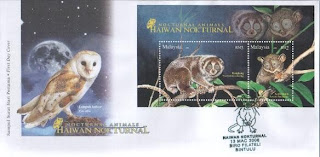 Animals live in virtually every type of habitat available in the Malaysian rainforest and even exploit man-made habitats. One interesting feature in animal ecology and behaviour is that some animals travel and feed mainly by night (nocturnal) as opposed to animals that move about during the day (diurnal). Various birds, mammals and reptiles have evolved towards a nocturnal way of life for numerous reasons. Due to the reduced amount of light at night, strictly nocturnal animals generally have good night vision to allow them to seek out prey and to avoid predators.
Animals live in virtually every type of habitat available in the Malaysian rainforest and even exploit man-made habitats. One interesting feature in animal ecology and behaviour is that some animals travel and feed mainly by night (nocturnal) as opposed to animals that move about during the day (diurnal). Various birds, mammals and reptiles have evolved towards a nocturnal way of life for numerous reasons. Due to the reduced amount of light at night, strictly nocturnal animals generally have good night vision to allow them to seek out prey and to avoid predators. Moonrat (Echinosorex gymnurus)
Moonrat (Echinosorex gymnurus)Generally solitary, this small mammal is strictly terrestrial and confined to the forest floor, often frequenting areas by the streams and is known to be active by day. It has a very strong body odour in the wild. Earthworms, beetles, spiders and snails are amongst the things it feeds on.
Malay badger (Mydaus javanensis)
The Malay badger is a terrestrial animal and is known for its very strong odour. It sleeps in underground burrows and feeds mainly by digging into the ground for food such as earthworms and insect larvae. Although found in mature forests, it is apparently more frequently seen in secondary forests and open ground such as gardens.
 Golden Cat (Catopuma temminckii)
Golden Cat (Catopuma temminckii)Little is know on the ecology and life history of this medium sized cat. Its coat of golden colour is largely unmarked and adults can weigh as much as 12 kilogrammes. Although terrestrial, it can apparently climb trees when necessary. Its prey includes mousedeer, birds, lizards and other small animals.
 Flying Fox (Pteropus vampyrus)
Flying Fox (Pteropus vampyrus)This is the largest bat in Malaysia bat in Malaysia and a full-grown adult can weigh more than a kilogramme. Large roosting colonies of this bat are often found in mangroves or nipah palm. This bat is known to fly long distances to feed on flowering or fruit trees and it is an important pollinator of many forest trees including durians.
Slow loris (Nycticebus coucang)
Largely arboreal, this primate which can weigh almost a kilogramme, is often found alone although couples with dependent young are sometimes seen. It feeds on small animals, mostly insects and on pulpy fruits. It lives in mature and secondary forests as well as in gardens and plantations.
 Tarsier (Tarsius bancanus)
Tarsier (Tarsius bancanus)This small primate of less than two kilogrammes is active from ground level to al least seven metres and generally leaps from tree to tree. It feeds mainly on large insects and is often solitary. Tarsier is known to make high pitch calls frequently and can be found in both mature and secondary forests.
 Technical Details
Technical DetailsDate of Issue : 13-Mar-2008
Stamp Value : 30 Sen (2 Designs); 50 Sen; RM 1
Sheet Content : 20 Stamps
Perforation : 14
Miniature Sheet Size : 120mm x 70mm
Paper : SPM Watermarked, Phosphor Coated
Printing Process : Lithography / Glow In The Dark
Printer : Percetakan Keselamatan Sdn Bhd
Stamp Designer : Hazel Design
First Day Cover Value : 30 Sen
Presentation Pack Value : RM 4.00
Miniature Sheet Value : RM 5 (RM3; RM2)
Folder Value : RM 5.50
The Start Online 15 March 2008, Tuesday Press Release
FOR the first time, Pos Malaysia has come up with special glow-in-the-dark stamps featuring unique nocturnal animals.
Much to the delight of many a philatelic collector, these stamps come in a miniature sheet measuring 120mm by 70mm and feature the slow loris/kongkang (RM3) and the tarsier/kera hantu (RM2).
Four other stamps, measuring 50mm x 30mm, will also be sold and they feature the tikus ambang bulan (moonrat) (30 sen), teludu (Malay badger) (30 sen), kucing tulap (golden cat) (50 sen) and keluang (flying fox)/ (RM1).
“Pos Malaysia has been dedicated in helping to enhance the public's knowledge about nature. These stamps were printed in two stages. One to print the actual stamp and the second time to layer on the coat of special glow-in-the-dark ink,” said PosNiaga Philately senior manager Wong Lai Kim.
Wong added there would be no more printing of the glow-in-the-dark stamps this year.

Corporate communications department senior assistant manager Maisara Noor Ahmad said Pos Malaysia was always looking for something different and unusual to feature on its stamps.
“The stamps are also a tool to create awareness among the people about nocturnal animals,” she said.
She added however that “that there would be many more interesting and one-of-a-kind stamps” from Pos Malaysia in the coming months.
>>> Read more about "Nocturnal Animals Stamps" <<<


